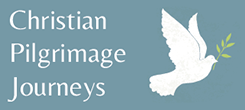
Karyes Settlement
Karyes is the administrative center of Mount Athos and is more of a town, it is also the public transport hub for the Holy Mount. In 9th century in Karyes was founded the biggest lavra which controlled the rest of lavras that time. The head of the lavra was called Protos (First) and the main church took the name Protaton (First Church). These names are still in use today.
Today Karyes consists of the church of Protaton, the Mansion of the Holy Assembly, nineteen buildings housing an equal number of depu¬tations of the holy monasteries called Konakia (as the monastery of Koutloumous is very close to the capital it has no Konaki), a few build¬ings housing shops and inns, the government of¬fices including the seat of the governor of Mount Athos, the police station, the dispensary, the post office, as well as eighty-two Kelia in and around Karyes inhabited by Greek, Russian, Bulgarian, Rumanian and Serbian monks.
The village of Karyes situated on a site full of trees and shrubs was much smaller a thousand years ago and was then called “Messi” (the Middle One). In the 11th century it was mentioned as the Lavra of Karyes and in the late 14th century as the skete of Karyes. Today Karyes is the headquarters of the Greek authori¬ties of Mount Athos, namely the governor and the police chief. But what really gives this township its character is that it is the seat of the Administration of this monastic state.
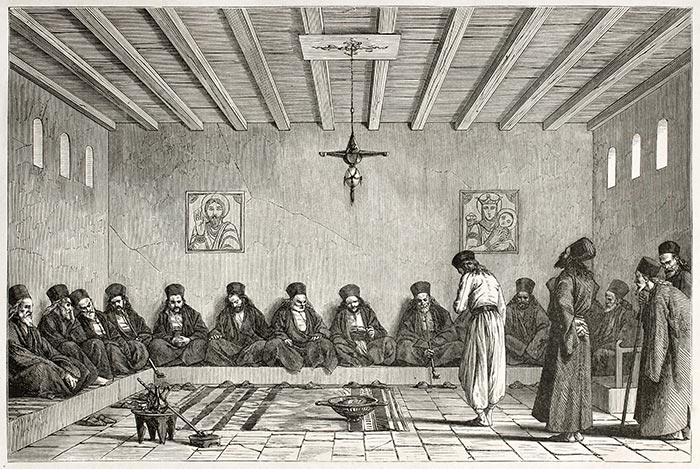
The twenty representatives of the monasteries assemble at regular intervals in the Mansion of the Holy Community and decide about matters concerning the interests of the Holy Mount. The Community of today has succeeded the old Congregation and the Holy Supervision (Ιερά Επιστασία – Iera Epistasia) with The Protepistate has replaced the Protos. They sit at a semicircular table-facing a small crescent shaped table close by, at which sit the secretary general and the clerks. The Protepistate, sitting on a kind of throne, calls the meetings to order, directs and adjourns them.
The Protepistate and three more dignitaries form the Holy Supervision, the authority which executes the decisions of the Holy Community, whose terms of office is one year. It is they who receive the visitors and issue "Diamonitirio"(the permission to visit). The secretary collects the names and the local police memos, prepares the permissions and presents them to the Holy Supervision for signing.
From time to time there are royalty or patriarchs among the visitors. The Ecumenical Patriarch Athenagoras, King Paul of Greece and Constantine the Crown Prince visited the Mountain during the celebration of its Millennium in 1963.
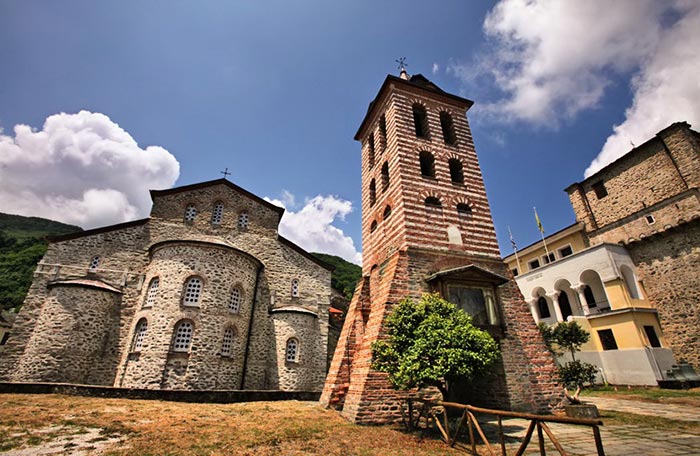
Right in the center of Karyes is the cathedral, called the Protaton. It is the only ancient basilica on Mount Athos. According to the local tradition, it was originally built by Emperor Constantine the Great (306-337), destroyed by Emperor Julian the Apostate (361-363) and restored by the monk Athanasios the Athonite, on donations of Emperor Nicephorus II Phocas. It is basically an edifice da¬ting from the 10th century, its exterior having only recently been restored. It is weIl-known for its famous murals which mark it out as a wonderful and unique Monument of Athos. Their recent cleansing allows one to examine them almost in their original beauty.
They were painted in the early stages of the Macedonian School, by Emmanuel Panselinos, the chief representative of this school of painting. They are in a very elegant style, born in Constantinople, the main characteristics of which are its wide stretching design, its freedom of expression, its realism, its vividness of move¬ment and gesticulations, its sensibility, which often reaches heights of dramatic passion. As the most characteristic murals we must mention those of “Anapesson” (the fallen-back-one), the Birth of Christ, the Baptism, the Presentation of the Virgin Mary and John the Baptist with the Prochoros, military saints and others.
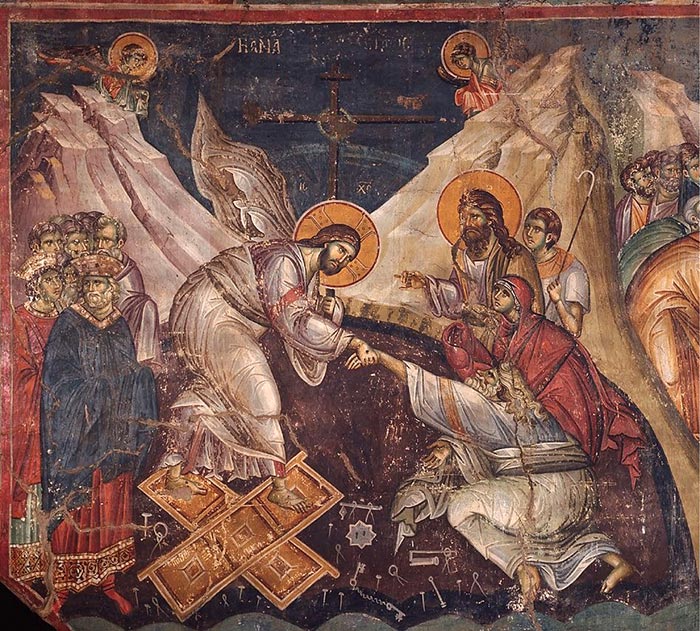
The icons of the rood¬screen belong to the Cretan School, the main characteristics of which are conservatism restrained movement and gesticulations, a certain serenity and expression or deep emotion, the shape or the countenances, the light on the protruding features or the faces etc.
The miraculous icon of “Axion Esti” is kept in the sanctuary. This is the saintliest icon of the whole monastic state. Placed on a throne behind the altar, it is about 3′ l’ by 2′ 2″ in size. The center of the icon is domi¬nated by the Virgin holding the Child Jesus, while its oblong perimeter is occupied by twenty small medallions, each picturing the patron saints of the monasteries of Mount Athos.
The following story is told about this icon. North-east of Karyes, in the direction of Pantokrator monastery and at a place called Sakos, there were a few kelia, one of them dedicated to the Assumption of the Bles-sed Virgin. One Saturday afternoon the Elder of this Keli before starting for Karyes, where he intended to attend the Agripnia(Vigils) at the church of the Protaton, instructed his ipotaktikos to read the Esperinos(Vespers) himself. That evening a young monk who was a complete stranger appeared at the Keli and begged leave to stay for the night, which was granted. Next morning, the ipotaktikos was preparing to chant Kosmas’s hymn to the Virgin Mother before her icon. This begins with “Την τιμιωτέραν των χερουβείμ” but he was in¬terrupted by the visitor who started chanting the then unknown hymn “’Αξιον εστίν ως αληθώς μακαρίζειν σε την Θεοτόκον, την αειμακάριστον και παναμώμητον και Μητέρα του Θεού ημών”.
Having finished this he continued with that of “Την τιμιωτέραν των χερουβείμ.” Greatly moved, the ipotaktikos begged the guest to write down the hymn for him. Finding no paper or ink he produced a marble slab on which the stranger carved the hymn with his bare finger. He ordered the monk that the hymn should thereafter be sung in praise of the Virgin. He then vanished. When the elder returned and was told what had passed between the ipotaktikos and the stranger, he at once notified the Assembly of the Elders at Karyes. Those had both the icon of the Virgin before which the angel-carved hymn was first sung, as well as the marble slab brought to the Protaton. The icon was placed on a throne in the sanctuary, with a hanging lamp burning before it day and night while the marble slab was sent to Constantinople and both the Emperor and the Patriarch were accordingly informed. Furthermore, they communicated the event to all the fathers on the Holy Mount, whom they instructed that the hymn should be sung henceforth. The Keli was named “Axion Estin” and its locality is still called “the Pit of Singing”.
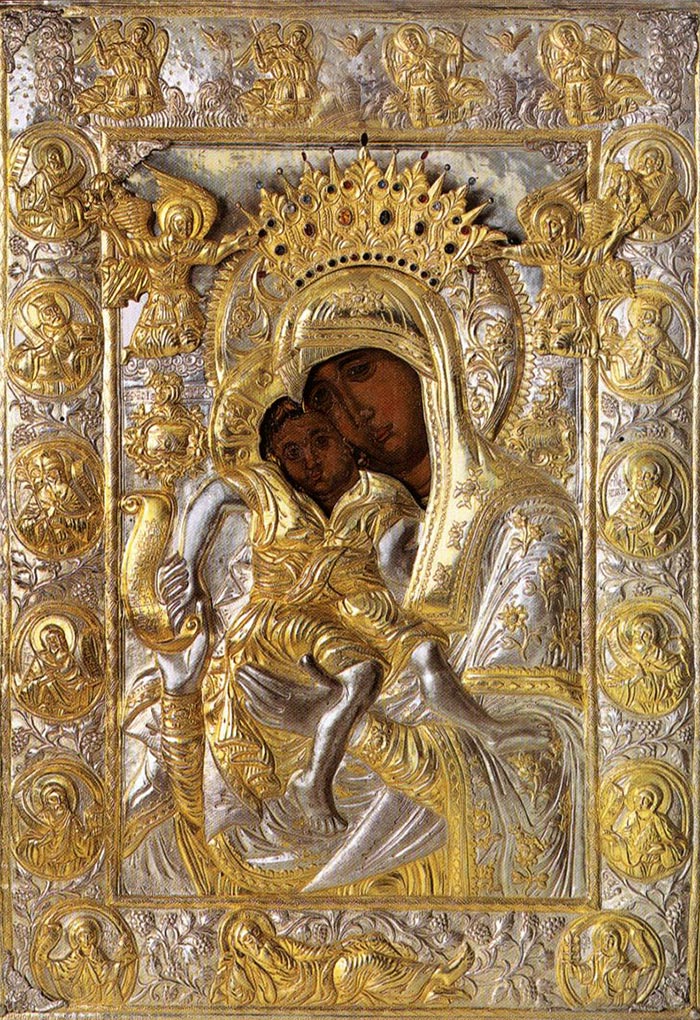
It is in this church that the deputies of the twenty monasteries, many monks of the capital and visitors attend services. On the right and left sides of the nave there are the twenty pews, reserved for the representatives of the monasteries.
South-east of the Protaton and not too far from it is the ancient tower housing the library of the holy Community. Besides its historical archives, this contains 82 manuscript codices, 42 of which on parchment, as well as several printed works. This is also where the first Ritual of the monastic state, written on a goat’s skin, is kept. That incidentally, is where it derives its name of "Tragos".
The town of Karyes is crossed from east to west by one main street. There are smaller lanes branch¬ing off left and right and leading to various Konakia and kellia. Along those alleys there are small workshops, or shops full of crosses, komboskinies (Prayer ropes), seals and holy-water cups, icons, mortars and pestles. These goods are sold to the visitors by the monks. The carvings of Mount Athos are really wonderful and well-known both in Greece and abroad.
All of a sudden, the “merchant” or “craftsman” locks up his shop or workshop and dashes into the chapel of his Keli to pray. The chapel is the center of his home, indeed the reason for its existence. And neither the time they devote in it, nor the money spent out of their frugal budget on decorating it is negligible. Even its exterior can easily be discerned. There is invariably a small slate-covered dome rising above the roof of each Keli.
The black dressed capital does not lack the smiles of life. There are a few pots with flowers on some balconies. The houses, usu¬ally surrounded with gardens, are old but mostly in a good state of repair. There are even a few new buildings.
Out of these houses the monks appear. They walk slowly and calmly. They wear rich beards, often snow-white quite a contrast to their black robes. There is something of an aristocrat about them and they give the impression of living in Byzantium. Nothing shocks them, nothing moves them. The quietness of Karyes is particularly impres¬sive. After all, silence is a distinctive mark of the whole Mount Athos. Everything reposes in the arms of silence, departed from secular life and its noisy worldly pursuits.
In Karyes there are two inexpensive inns with restaurants of medium quality, nothing compares to monastery food. All shops and restaurants are closing at 20:00. There is a good cell phone signal in Karyes as one of the cell connection providers got permission and built their tower on the top of the joining mountain.

